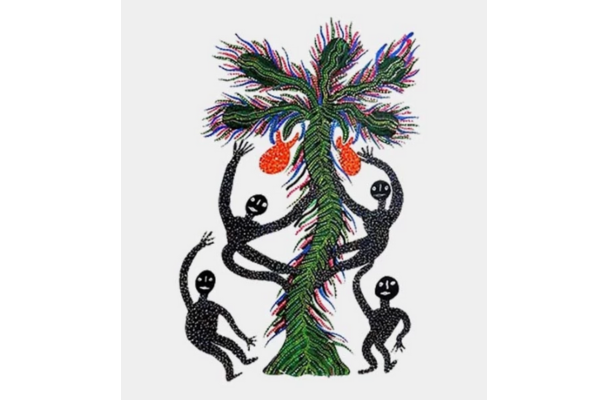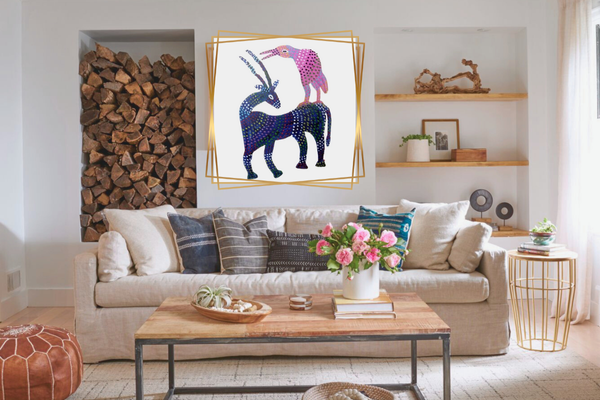Bhil Painting: A Journey into India’s Tribal Art, Culture & Legacy
India is a land of vivid colours, cultural diversity, and age-old traditions, which treasures many art forms. Amongst them all, Bhil Painting stands out as a beautiful expression of tribal life, mythology, and nature.

Bhil painting - A vivid glimpse into India’s tribal heritage (Image Source: Google)
As one of the oldest surviving Indian folk painting styles, Bhil art is more than just a visual treat — it’s a living narrative of the Bhil community’s history, rituals, and beliefs. If you’re drawn to art that tells stories, Bhil painting offers a window into the heart of India’s tribal heritage.
Who Are the Bhil Tribes?
Renowned for their deep connection with nature and wild living, the Bhils have been able to pass on their art heritage for generations. Bhil-style painting, typically carried out on domestic walls and later adapted to canvas and paper, talks about their environment, habits, deities, and daily lives.

Bhil community preserving centuries-old art through everyday expression (Image Source: Google)
Earlier, the Bhils used mud walls for painting by making use of pigments obtained from flowers, leaves, and stones. Currently, Bhil artists paint in acrylic with brushes, yet maintain the integrity of their approach.
What Makes Bhil Painting Unique?
The most noticeable thing about a Bhil painting is its characteristic use of dots. The dots are not merely for decoration but are used as narrative tools. Each dot carries meaning, signifying flora, fauna, dreams, ghosts, and rhythms of village life. The background is usually filled with compulsive repetition and movement, bringing about a feeling of harmony.

Unique dotted motifs in Bhil painting (Image Source: Gallery Unique Art)
Common Themes in Bhil Paintings:
Nature and animals – peacocks, deer, trees, and rivers
Tribal deities and legends – like Pithora and Devi
Festivals and rituals – Holi, weddings, harvest celebrations
Daily life – farming, hunting, and dancing
These themes offer viewers a glimpse into the lifestyle, faith, and philosophy of the Bhil people, making each painting a unique piece of authentic tribal art heritage.
Bhil Painting as an Indian Folk Art Form
Among all the various genres of Indian folk painting—like Warli, Gond, and Madhubani—Bhil art is special due to its narrative structure and visual beat. The style is richly symbolic, piecing together personal reminiscence with mythological narrative.
An example of this is where a Bhil artist might depict a harvest festival, but all the while mentioning stories of the gods or an ancestral spirit. In many ways, the vibrancy and rhythmic patterns create a connection to humanity beyond language and culture.
The Rise of Contemporary Bhil Artists
Over the past decades, Bhil artists have started receiving national and global acclaim. Bhuri Bai, a trailblazing woman artist from Madhya Pradesh, is one well-known name who was among the first to bring Bhil painting from walls to paper and canvas. Her paintings have been exhibited in Indian and international galleries, and she has received numerous prestigious accolades, including the Padma Shri.

Bhuri Bai, a female Bhil artist, received the Padma Shri Award from the President of India (Image Source: Wiki)
Famous Bhil Artists to Know:
Lado Bai – known for her strong female perspective in art
Sher Singh Bhil, whose work explores tribal mythology and nature
Durga Bai Vyam (although primarily Gond, she collaborated with Bhil artists)
These artists have preserved traditional themes while experimenting with scale, colour, and contemporary narratives, helping Bhil painting evolve into a dynamic art form.
Why Bhil Painting Matters Today
In a fast-paced, digital world, Bhil painting connects us to a slower, more grounded way of life — one that values nature, community, and spiritual harmony. Buying or supporting authentic tribal painting isn’t just about owning beautiful art — it’s about:
- Preserving cultural heritage
- Empowering tribal artists economically and socially
- Bringing Indigenous voices into mainstream art spaces
Whether displayed in homes, galleries, or museums, Bhil paintings invite you to pause, reflect, and appreciate India’s rich tribal wisdom.
How to Choose the Right Bhil Painting for Your Space
Bhil painting will add not only a burst of colour but also cultural richness to your office or home interior. Here are some guidelines for selecting the right work:
Size: Large paintings can be used as statement pieces in lobbies or living rooms.
Colours: Bhil art is vibrant — look for colours that complement your existing palette. For earthy or minimal interiors, a colourful painting can act as a bold contrast.
Themes: Choose themes that resonate with you. Love nature? Go for wildlife and forest scenes. Interested in Indian culture? Opt for depictions of festivals or folk stories.
Tips for Displaying Tribal Art Beautifully:
- Use black or wooden frames to allow the colours to stand out.
- Place it at eye level and make sure it is well-lit (avoid direct sunlight).
- Pair with plants, handwoven fabrications, or terracotta pieces to add to the tribal look.
How to Support and Collect Bhil Art
If you’re interested in collecting Bhil art, look for platforms and organizations that work directly with tribal communities. Many artists now sell their work online or through government-supported exhibitions and NGOs. When you purchase from them, you’re not just acquiring a painting — you’re participating in the preservation of a cultural tradition.
Also, always look for certifications or assurances that the work is original and not a mass-produced imitation. Supporting a genuine Bhil artist ensures authenticity and helps keep this beautiful tradition alive.
Why Buy Paintings from Gallery Unique Art?
At Gallery Unique Art, we curate authentic tribal paintings directly from skilled Bhil artists. Every piece you see is handcrafted with love, history, and cultural significance. Here's why buying from us makes a difference:
Authenticity guaranteed – No mass reproductions, only original artwork
Support local artists – Your purchase empowers tribal communities
Documentation provided – Artist bio and artwork details included
Secure packaging & delivery – Art reaches you in pristine condition
When you invest in a Bhil painting from us, you're not just decorating a wall—you're preserving a cultural legacy.

Tribal tradition meets modern living, painting from Gallery Unique Art
Explore more Bhil paintings & artwork
Bhil Painting Care Guide
Preserving your Bhil artwork ensures its beauty and significance lasts through generations. Though these paintings are durable, a little care goes a long way.
Cleaning Tips for Tribal Paintings:
- Gently dust the painting using a soft, dry cloth or a microfiber duster.
- Don’t use water or cleaning products on the painting itself.
- If your painting has a glass frame, clean only the glass, not the painting inside.
How to Protect from Sunlight and Moisture:
- Don’t hang the painting in direct sunlight — it can make the colours fade.
- Keep it away from damp places like the bathroom or kitchen.
- If you need to store it, wrap it in acid-free paper and keep it in a cool, dry place.
Bhil painting is not only art — it's a link to India's ancient tribal past, a bridge between the old and the new. When you look at the vibrant dots creating trees, animals, and gods, you're not only appreciating an artwork; you're connecting with a living heritage.
In helping Bhil painters and honouring genuine tribal art, you help preserve India's original cultures — a brushstroke at a time.
Read More: Why Indian Folk Art is Gaining Popularity as Handmade Wall Décor
Frequently Asked Questions
1. What are the materials used in Bhil paintings?
Natural colours from leaves, charcoal, flowers, and stones were traditionally employed in Bhil paintings. Contemporary Bhil artists now paint with acrylic colours and brush on canvas or paper, yet maintain the symbolic motifs and dot patterns of their forbears.
2. In what ways is Bhil painting distinct from other Indian folk paintings?
Unlike the stick figures in Warli or the decorated borders of Madhubani, Bhil paintings use bright colours and recurring dots. The dots are exclusive to Bhil's painting and signify community, continuity, and harmonious existence in tune with nature.
3. Can Bhil's painting be customized for modern decor?
Yes! Most modern-day Bhil painters produce pieces in different sizes, themes, and styles that complement contemporary interiors. From wall hangings to framed canvases, Bhil paintings can exquisitely adorn both traditional and modern homes.


Related Blog